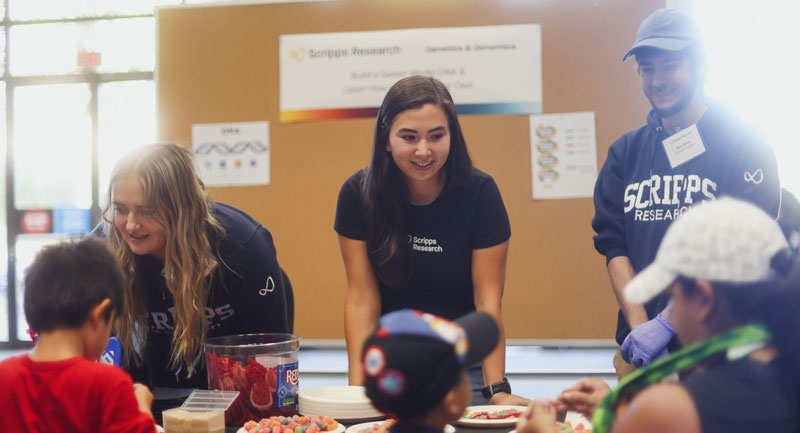
On November 10, 2024, Scripps Research continued its year of centennial celebrations with an afternoon of interactive discovery at the Fleet Science Center in San Diego’s Balboa Park. The event coincided with the annual World Science Day for Peace and Development and highlighted the renowned institute’s 100-year anniversary.
Approximately 50 Scripps Research graduate students and postdoctoral research fellows hosted over a dozen hands-on activities and science demonstrations for members of the public. Activity stations throughout the center enabled Fleet visitors to explore topics in neuroscience, cell biology, chemistry, drug discovery, viruses and vaccines, and much more. Visitors also had a chance to interact with up-and-coming Scripps Research scientists who shared their passion and enthusiasm for the cutting-edge research projects they’re pursuing.
Underscoring the institute’s commitment to applying scientific discoveries toward the public good, the event was held on World Science Day for Peace and Development, an annual commemoration held by the United Nations on November 10, dedicated to highlighting “the significant role of science in society and the need to engage the wider public in debates on emerging scientific issues. It also underlines the importance and relevance of science in our daily lives.”
Some of the featured activities included:
- Experiencing the molecular magic of chemistry as Scripps Research chemists made ice cream with liquid nitrogen, created invisible ink from everyday household materials and combined chemicals to make instant nylon.
- Becoming immersed in the tiny but complex world of viruses by wearing state-of-the-art augmented reality headsets and using hand controllers to explore many different types of well-known viruses.
- Learning about the wonders of biology by using microscopes, watching an enzymatic reaction as lactase degrades the lactose found in milk, and extracting DNA from strawberries.
- Building delicious DNA models with candy vines, gumdrops and toothpicks.
- Using everyday scientific tools and wearing the attire of today’s researchers and a hands-on pipetting activity.
- Watching a colorful demonstration of how researchers discover and develop new medicines by performing a process called thin layer chromatography (TLC), a technique used by scientists at Calibr-Skaggs, the drug discovery division of Scripps Research.
- Crafting colorful brain cell (neuron) models from pipe cleaners and beads, building and coloring an origami-style brain anatomy hat and learning about the sensory breakthroughs that earned Scripps Research neuroscientist Ardem Patapoutian the Nobel Prize.